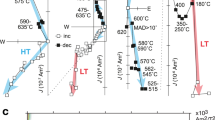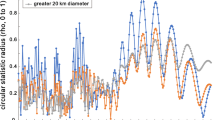Abstract
Spence speculates that Egypt's pyramid builders found true north by using a plumb line: when the stars Kochab and Mizar were seen on the same vertical, one was facing north1. As evidence in support of this hypothesis, she points to the proposed interstar-line precession past the north celestial pole at a rate of 27′ per century (cy). We argue that a mathematical error affects this result, which when corrected points more strongly to a different pair of stars. This suggests that the conventional ancient chronology, instead of being compressed, may actually have to be expanded slightly.
Similar content being viewed by others
Main
The elementary error here is that the interstar-line drift of 27′ cy−1 occurs at an altitude of 30° (Giza's latitude), but to apply this drift to ground orientation, one must divide by cosine 30°. So, on the ground, 31′ cy−1 is the actual misorientation rate. Thus, the actual drift rate is significantly greater than Spence's empirical rate of orientation change of the pyramids themselves (the slope of line a in Fig. 4 of ref. 1).
When the pyramids were built, only two stars brighter than fifth magnitude lay anywhere near the pole: Thuban (3.65 mag, 1.5° distant) and the irregularly variable star 10 Draconis (4.5–5.0 mag). In 2627 bc, the pole was equidistant (1°) from each star, so the pole was the obtuse apex of a squat isosceles triangle formed between itself and the two stars. When both stars were at the same altitude, north was the direction bisecting them. (For more than a millennium after 2627 bc, there was no star brighter than 10 Draconis nearer to the celestial pole.)
Among several mechanical methods, north could have been determined in the dark by sighting the two horizontal stars simultaneously against a pointed post, the pyramidal top of an obelisk, or any similar object; when the observer can eclipse both stars simultaneously on opposite sides of the peak, the line from the observer to the peak points northwards. This simultaneous-eclipse method does not require the post or obelisk to be illuminated, making it simpler than Spence's plumb-line method; there is no easy way to see a plumb line at night while retaining the observer's night-vision acuity.
Although 10 Draconis is barely visible under modern industrial skies, it is recorded in all four large preclassical naked-eye star catalogues: Hipparchos, 128 bc; Ulugh Beg, ad 1437; Tycho, ad 1601; and Hevelius, ad 1661. Spence's Kochab and Mizar are indeed brighter than Thuban, but the eye-precision she assumes implies that the Kochab–Mizar line will confusingly pass into detectable and uncentred non-verticality in a matter of a few (perhaps ten) seconds. (Spence's suggestions of 5-year or 1–2-year precision for dating the pyramids imply a surveying precision of about 1′.) So Spence's method, although possible, would require agile quickness. In contrast, the midpoint between Thuban and 10 Draconis gives a ground orientation within 1′ of true north for over 5 minutes on either side of its transit. The very slow motion of these stars (and the small size of any potential orientation error from their use) is due to their close proximity to the celestial pole.
The precision of raw, naked-eye stellar observations can be significantly better than 3′, but we justify the utility of our two stars by reference to the scrupulous naked-eye catalogues of Tycho and Hevelius2,3. Tycho's raw data survive for both stars4, eight observations in all: r.m.s. errors are 2′ for Thuban and 3′ for 10 Draconis. In Hevelius' catalogue, the equatorial coordinates of Thuban and 10 Draconis (his Draco stars 8 and 32) have great-circle errors of 1′ and 0′, respectively. Thus, the dimness of 10 Draconis was in itself no barrier to accurate measurement of its position in pre-industrial times, and such precision could easily be replicated for an azimuth observation, even using simple instruments, by positioning the observer's eye at a large enough distance from the eclipsing post.
In 2627 bc, the misorientation associated with our obvious and straightforward method was null but precessionally increasing at 27.4′ cy−1 in azimuth, which matches Spence's 28′ cy−1 empirical rate much more closely than her Mizar–Kochab method (31′ cy−1). This implies dates of 2638 bc for Khufu's pyramid and 2607 bc for Khafre's. (Error estimates could be 2–10 years, depending on assumptions regarding the builders' craftmanship.) These dates are a few decades outside the conventional ranges Spence cites5. But our implied date for the ascension of Khufu (2640 bc) is twice as near to a conventional boundary as Spence's 2480 bc (Table 1 in ref. 1). Back-disparity makes more sense than Spence's very forward dates, when current orthodoxy is based on king lists that are “seldom complete”1.
It seems odd that either method would have been used before the time when it was correct. Because the best pyramid orientations occur for the two greatest pyramids, this could simply indicate that engineering science peaked at the time of Khufu– Khafre. Thuban passed within 0.1° of the pole in 2800 bc, a chance event that may have stimulated the historical flowering of celestially based surveying, which was unquestionably used for the pyramids built soon after that at Giza. A stellar explanation of the Giza pyramids' location (in latitude) has already been proposed6.
Latitude (but not orientation) could be found in a single night near the time of the winter solstice anywhere close to 2600 bc by bisecting Thuban's circumpolar semicircle, because this star was within 10° of the equinoctial colure for centuries after 2700 bc. Because 10 Draconis was within 10° of the solstitial colure for three decades either side of 2613 bc, on the same or any neighbouring night, orientation might also have been found by bisecting the circumpolar arc of 10 Draconis. Although twilight would have cut the arc to slightly less than 180°, this still would have been adequate for the purpose. By coincidence, both orientation methods that depended on 10 Draconis were most accurate at virtually the same time: 2627 bc for the Spence interstar method applied to Thuban and 10 Draconis, and 2613 bc for the 10 Draconis arc method.
Before Spence's proposal1, a possible connection was suggested7 between precession and the pyramids' misorientation, but the horizon-based observations proposed would be too prone to difficulties with high refraction, uneven topography, dip and atmospheric extinction to be practical. So, despite a few disagreements, we welcome Spence's creativity in pointing out the possibilities of orienting the pyramids by observing northern stars higher in the sky and near to the meridian, which doubly minimizes corruption by refraction.
References
Spence, K. Nature 408, 320–324 (2000).
Rawlins, D. Isis 73, 259–265 (1981).
Rawlins, D. DIO Int. J. Sci. Hist. 3, 3–106 (1993).
Dreyer, J. L. E. (ed.) Tychonis Brahe Dani Opera Omnia Vol. 11, 382 and Vol. 12, 170 (Societatis Linguae et Litteratum Danicarum, Copenhagen, 1913–29).
von Beckerath, J. in Chronologie des Pharonischen Ägypten 188 (von Zabern, Mainz, 1997).
Rawlins, D. Vistas Astron. 28, 255–268 (1985).
Haack, S. C. J. Hist. Astron. 7 (suppl.), 119–125 (1984).
Author information
Authors and Affiliations
Corresponding author
Rights and permissions
About this article
Cite this article
Rawlins, D., Pickering, K. Astronomical orientation of the pyramids. Nature 412, 699 (2001). https://doi.org/10.1038/35089138
Issue Date:
DOI: https://doi.org/10.1038/35089138
Comments
By submitting a comment you agree to abide by our Terms and Community Guidelines. If you find something abusive or that does not comply with our terms or guidelines please flag it as inappropriate.



